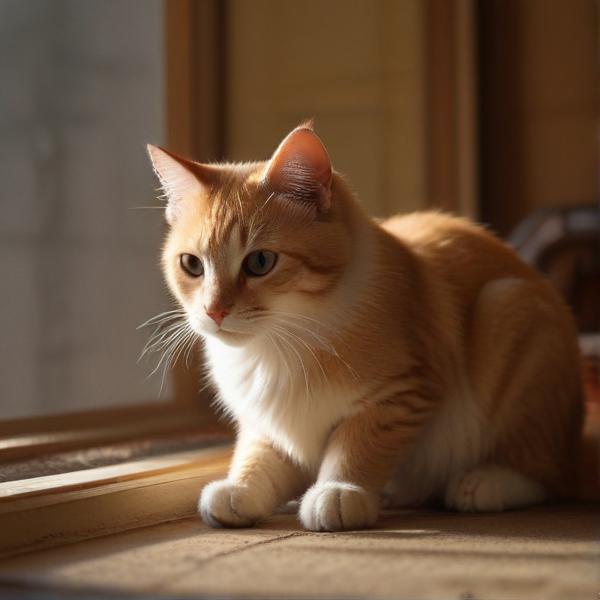基本信息 (Basic Information)
含义与用法 (Meanings & Usage)
中文核心释义 (Core Chinese Meaning): 猫,一种常见的小型家养哺乳动物,喜欢捕鼠,是人类常见的宠物。
英文核心释义 (Core English Meaning): cat, a common small domesticated mammal, often kept as a pet and for catching mice.
象形意义 / 为何这么写 (Pictographic Meaning / Writing Rationale)
文言文释义 (Classical Chinese Meaning)
与现代意义相近,古代‘猫’也指家猫或野猫。Similar to modern meaning; in ancient times, '猫' also referred to domestic or wild cats.
深入学习 (In-depth Study)
字源故事 (Origin Story)
字形演变 (Character Evolution)
常用词语和例句 (Common Words & Examples)
猫咪 (kitty, kitten; affectionate term for cats)
我家养了一只可爱的猫咪。
Eng: My family has a cute kitty.
猫眼 (peephole (in a door); literally 'cat eye')
请通过猫眼看看是谁在门外。
Eng: Please look through the peephole to see who is outside the door.
猫步 (catwalk (as in fashion show); walking lightly like a cat)
模特在舞台上走猫步。
Eng: The model is walking the catwalk on the stage.
相关成语 (Related Idioms)
猫哭老鼠
Meaning: to shed crocodile tears (to pretend to be sympathetic or sad while being the cause of the trouble)
多语言翻译 (核心释义) (Translations (Core Meaning))
- French: chat
- German: Katze
- Spanish: gato
- Italian: gatto
- Portuguese: gato
- Russian: кот; кошка
- Arabic: قطة
- Persian: گربه
- Dutch: kat
- Polish: kot
- Vietnamese: mèo
- Ukrainian: кіт; кішка
视频学习资源 (Video Learning Resources)
通过以下链接在热门视频网站搜索 "猫" 的更多讲解:
Search for more explanations of "猫" on popular video sites:
- 在 Bilibili.com 搜索 "猫 字源 说文解字" (Search on Bilibili)
- 在 YouTube.com 搜索 "猫 character origin etymology" (Search on YouTube)
网络参考 (Web References for "猫") ()
网络内容摘要 (Web Content Summary):
```html猫是汉字“貓”的简化或异体字,常见于现代汉语,指一种以发出“喵”叫声著称的驯良小型哺乳动物,即“cat”。 猫 (māo) is the simplified or variant form of the character “貓”, commonly used in modern Chinese to refer to the small domesticated mammal known for its "meow" sound — the cat.
- 字形起源方面,“貓”是形声字,由“豸”(zhì,表示兽类)和“苗”(miáo,声旁,模仿“喵”的叫声)组成,形象地表达了会“喵喵”叫的野兽。 Etymologically, “貓” is a phono-semantic compound: “豸” suggests a beast, while “苗” provides the sound and mimics the "meow" cry — together denoting an animal that makes a "meow" sound.
- 常用词有:“猫咪”(cute form of cat)、“猫眼”(peephole, or cat's eyes)、“猫头鹰”(owl)。 Common words: “猫咪” (kitten or cute cat), “猫眼” (peephole or cat’s eye), “猫头鹰” (owl).
- 容易与“猫”混淆的近形字有限,但要注意“貓”是更为正式和传统的书写。 There is little risk of confusing “猫” with other characters, though “貓” is the traditional and formal version.
- 文化中,猫常寓意灵活、玲珑、机敏,也与吉祥或守护驱邪相关联。 Culturally, cats symbolize flexibility, cleverness, and in folklore, are sometimes seen as lucky or protect against evil.
汉字"猫"的起源、演变过程-汉字字源辞典
"猫 "是" 貓 "的异体字。 苗 ,既是声旁也是形旁,拟动物发出的" 喵 "的叫声。 猫 ,篆文 (豸,野兽) (苗,拟"妙"的叫声),表示会"妙妙"叫的野兽。 有的篆文 以"反犬旁" 代替"豸" 。 造字本义:名词,发"喵"的叫声的动物,视听敏锐,性情驯良乖巧,善于跳跃攀援,是鼠 ...
猫(汉语文字)_百度百科
"猫"本为异体字,本字作"貓",为形声字,从豸,苗声。后世"豸"或省写作"犭",改为从犭,苗声。宋代的《集韵.平声.宵韵》就有收录,"貓猫"下云:"《尔雅》虎窃毛谓之虦猫。
更多图片 (猫 More Images) ()
